Vinyl records are a relatively old audio medium by today’s standards, but this medium is making a resurgence in modern music and has become more popular in recent years. This leads many music lovers to wonder how these vinyl discs work, how music is played from them, and how they are made. Let’s answer these questions as we explore this audio medium a little deeper.
Vinyl records are phonograph records made from PVC. These records are made with audio recordings that are pressed into the record. These grooves are read by a record player needle which vibrates with the grooves. The vibrations are transferred to a speaker, which generates the audible audio.
The vinyl record is a fascinating thing, and even though it has been around for more than a hundred years, not many people really understand how they work or how music can be played from them.
Everyone who loves music should understand vinyl records, as they are such a significant aspect of musical history. With that in mind, this is how vinyl records work.
What Is A Vinyl Record?
Vinyl records have been around since the 1920s, and audio discs have existed for far longer than that. Even though this musical medium is so old, few people in the modern understand what these records are and how they work. Let’s begin by identifying what exactly vinyl records are.
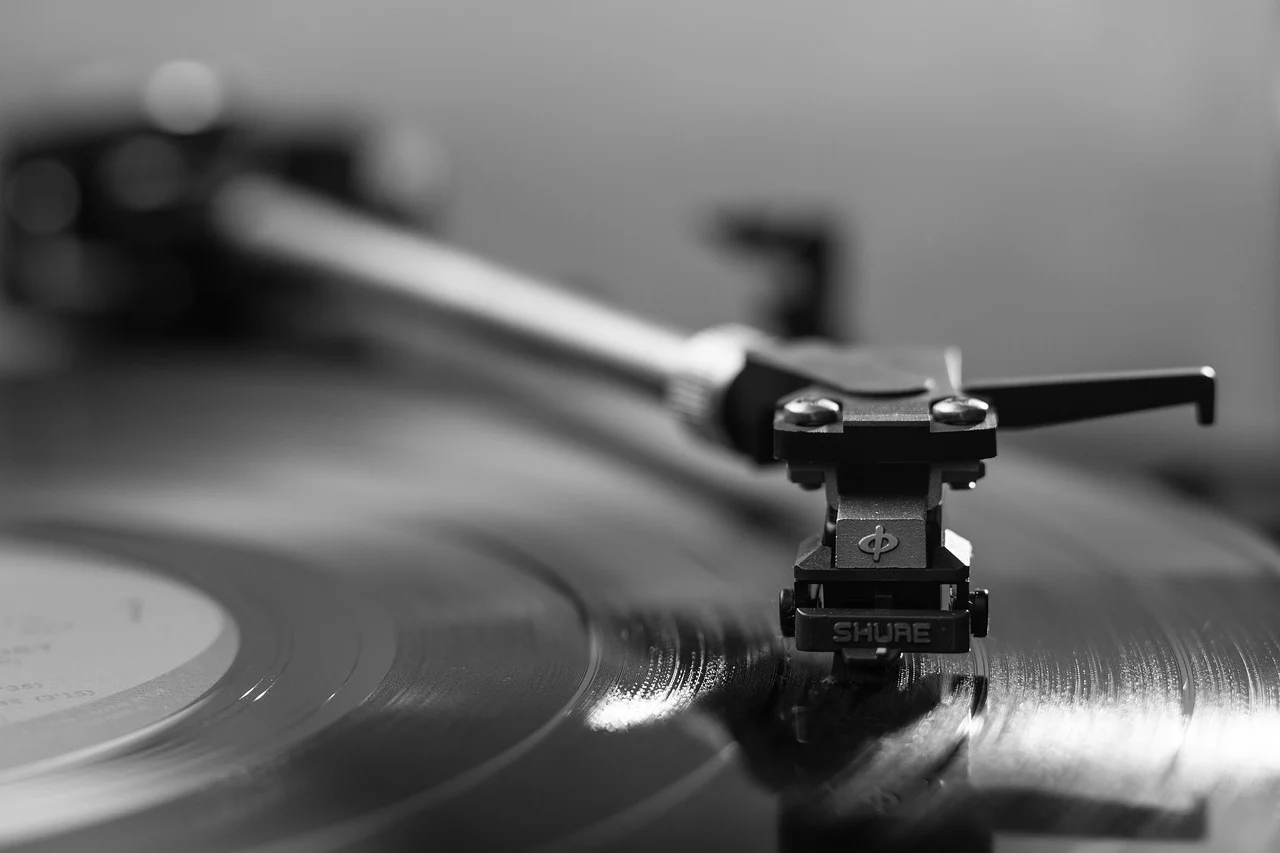
Modern vinyl records are a form of phonograph record. A phonograph record is an analog audio or sound storage medium that takes the form of a flat disc with a modulated spiral groove inscribed into it.
This definition may seem complicated, but the truth is that these are just complicated words that explain a very simple device.
To simplify, a vinyl record falls into the category of phonograph records, which are flat discs made of any material that has a spiral groove carved into them that represents audio waves.

This definition is important because the only way to retrieve the audio from a disc like this is by running a needle through the spiral groove in the disc, causing it to vibrate and subsequently amplifying those vibrations into a sound that we can hear.
The definition of a phonograph record is important because it indicates how the record is made and how the audio from the record can be played. There is only one definition of both, and the vinyl record falls in this specific audio medium category.
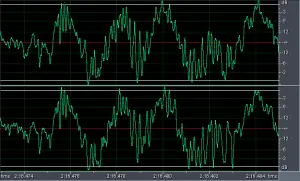
The term “vinyl” in vinyl records refers to the material that the records are made from. All vinyl records are made from polyvinyl chloride, also known as PVC or vinyl, which is a combination of chloride from salt and ethylene from crude oil.
Therefore, a vinyl record is, by definition, a phonograph record made from polyvinyl chloride. This is the exact definition, but there is more to these audio storage devices than just a definition.
Let’s explore vinyl records further to discover how they are made, how they work, and how they are played.
How Are Vinyl Records Made?
Vinyl records are hailed by many audiophiles to be the superior music medium, and these records have maintained a dedicated following ever since their inception. The process of how vinyl records are made is among the many reasons why this type of music lover appreciates these records so much.
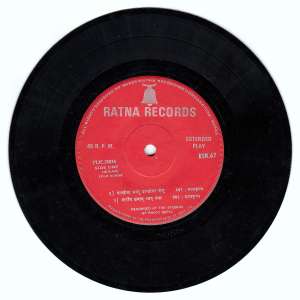
The process of creating vinyl records has been streamlined over the years, but the most modern methods of making vinyl records are the same as they have been for the last few decades.
The fact that this is analog technology means that it cannot advance past a certain point, which means that the technology behind the manufacture of vinyl records has reached the point where it will not change, as there is nowhere left to take it.
With that being said, the process is still interesting and fascinates many music lovers internationally. The process is simple in some stages and very complex in others, but the overall manufacture of vinyl records is quite simple to understand.
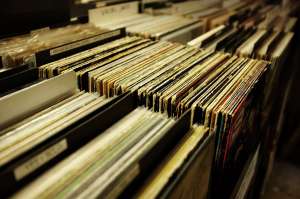
Vinyl records are made by first transferring an audio recording or live musical performance onto a lacquer “mother disc.” This process is done with a record lathe that has a ruby inscribing needle that carves the audio into the disc.
The inscribing needle is vibrated by the audio of the recording or live performance, and the vibrations of the needle match the audio to perfectly carve the same indentations into the disc as the waveform of the music.
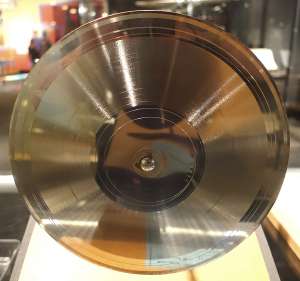
Once the mother disc is formed, it is sent to a processing plant, where it is used to create a “master disc.”
The master disc is made by first cleaning the lacquer mother disc to rid it of any contaminants, and then the mother disc is submerged in liquid silver. This silver fills all of the grooves of the disc and solidifies over the entire surface.
The disc is then placed in a nickel solution bath to harden the silver. After this, the disk is trimmed and cleaned, and the silver template is removed from the mother disk. The silver template becomes the master disc.
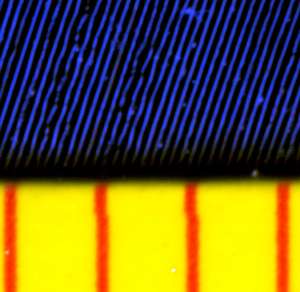
The master disc is a perfect opposite of the mother disc, as it has raised ridges rather than indented grooves. These ridges are an exact mirror copy of the music carved into the mother disc.
The fact that the master disc has ridges rather than grooves is important because it is used to press grooves into the final vinyl records.
The vinyl records themselves begin as PVC shavings or chips or scraps from the process of making other records. The PVC is melted into small, thick pucks of plastic resin that are fed into a record press.

Within the record press, the vinyl is exposed to high temperatures and steam to make it pliable, and the metal master disc is pressed into the vinyl to leave the grooves that hold the music.
This pressing process also flattens the disc to a thin profile. The vinyl is cooled in the machine, and any excess vinyl is trimmed off, leaving the record with its final dimensions.
After the record has gone through this process, it is ready to be played. This analog process really is that simple.
How Do Vinyl Records Work?
We have explored what vinyl records are and how these devices are made, but how do vinyl records work? How does the sound that is carved into the plastic resin of a record translate to audio that you can hear with your own ears?
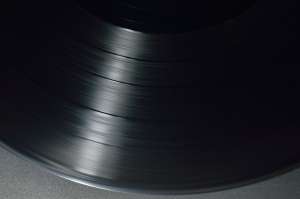
The how of vinyl records is as simple and simultaneously complicated as the what of vinyl records. The technology that goes into translating the grooves in a record into audible music is simple yet somewhat challenging to understand, so let’s try to make it as straightforward as possible.
Vinyl records produce sound when they are played by a record player. Record players are equipped with a needle that is tipped with a very hard material, such as diamond so that the tip of the needle will never bend or become dull.
The tip of the needle fits perfectly into the grooves that are pressed into the vinyl, and the other end of the record needle is attached to a stylus arm that is mounted to an incredibly sensitive electromagnetic sensor.

The sensor is very simple but also very sensitive. This electromagnetic sensor is simply two magnets that are wrapped with copper wire to generate a simple electromagnetic field.
As the record rotates in the player, the needle is pulled through the grooves in the plastic and vibrates accordingly.
Those vibrations are transferred by the stylus up to the electromagnetic sensor, and the end of the stylus disturbs the electromagnetic field at precisely the same frequency as the vibrations from the needle, which are exactly the same frequency as the music that was recorded and pressed into the vinyl.

The electromagnetic sensor is connected to an electrical circuit which is turned on and off very rapidly as the stylus vibrates and disturbs the electromagnetic field. These rapid on/off cycles are interpreted by the circuit as an electrical signal.
This circuit is connected to a speaker cone, and the on/off cycles are translated into the movement of the speaker cone, making the speaker cone resonate at the same frequency as the record player needle.
As the speaker cone vibrates, it moves the air in front of it at the same frequency, and the air then transfers the vibrations of the audio frequencies to your ears, which your brain can then interpret as music.
This entire process is essentially a system of transferring vibrations from one medium to another and amplifying them along the way until they are powerful enough to vibrate air enough for the vibrations to be transferred by your ear to your brain.
Are All Vinyl Records The Same?
Modern vinyl records are as interesting today as the original vinyl records were when they were first manufactured. This simple process of simplifying music to tangible vibrations and transferring it to your ear through complicated processes is fascinating, but are all vinyl records the same as each other?
Vinyl records in the modern world are all fundamentally the same. All of these records work in the same way, and they are basically made in the same way as well, with some minor automation and workflow differences.

Records can be made into different colors and different thicknesses, and they can be made stronger or weaker depending on the compounds that go into making the vinyl for the records.
Records that are pressed with a master disc that has not yet been used sound clearer than records pressed with a master that has already pressed thousands of records, which creates a discrepancy within the medium, but all vinyl records are fundamentally the same.
The quality of the master disc that is created also determines the output audio quality, so how the master is made also makes a difference between manufacturers.
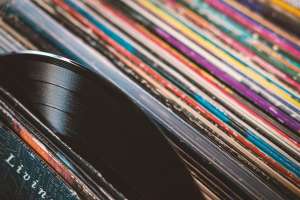
Apart from some small manufacturing discrepancies, all modern vinyl records should be the same, but phonograph records were not always made from vinyl.
The original phonograph records were made from shellac, which is a resin produced by an insect native to Asia. This resin is harvested, processed, and dissolved into alcohol to form liquid shellac resin, which is then used for pressing records for production.
These records were brittle and fragile, which is why records were made from vinyl as soon as the material was invented.
Shellac records to still exist today but very are manufactured, and they are considered collector’s items rather than legitimate audio devices.
Are Vinyl Records Still Made Today?
If this deep dive into vinyl records has piqued your interest and made you want to explore the world of phonograph records for yourself, you may be wondering if vinyl records are still produced today?
Vinyl records are still made today in the modern world. In fact, the demand for vinyl records has increased so much in the last few years that record manufacturers have had to increase the scale of their production to meet the demand.
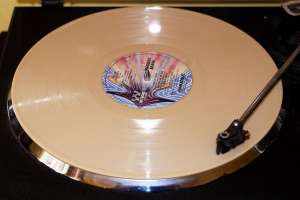
However, there are far fewer functional record plants operating in the world than you may imagine, especially compared to how many records are made and how much digital music is created internationally every day.
There are around twenty active record pressing plants in the United States and many more internationally. Most of these pressing plants are automated and operate 24/7, but there are a few, such as the pressing plant at Third Man Records, that use manual record presses that are operated by workers in the plant.
The records that are produced in the modern world are seen as luxury items, and so they are made to very high standards. This increases the quality of the audio that they produce and makes the records more expensive to manufacture.
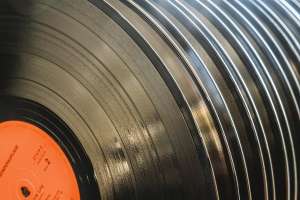
Modern vinyl records are very high quality and made with excellent vinyl material. Every record plant has its own signature style and produces records that are slightly different from the others.
Most records batches are made to order by individual artists and sold as limited-edition pieces to those who are interested in this audio medium.
Conclusion
Vinyl records are immensely interesting with a fascinating history and complicated manufacturing process, but more than that, they represent an entire era in musical history that is beloved by many music lovers even now in the 21st century.
There is nothing like a vinyl record, so if you have never experienced the audio from one of these discs, find someone who has a record player and a collection of LPs and ask them to show you what you have been missing! You will not be disappointed.
You can learn about whether to use active or passive speakers for vinyl here.
You can also use studio monitors to listen to vinyl – you can learn more here.
You can learn more about the history of vinyl records here.
